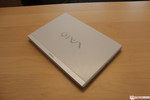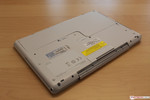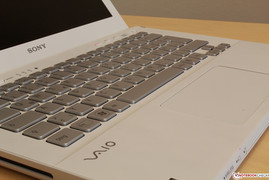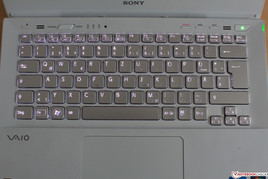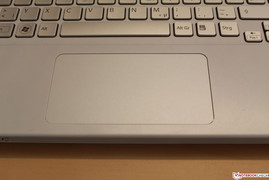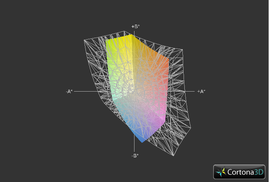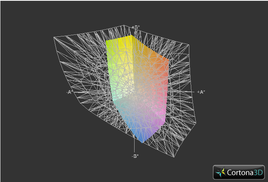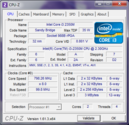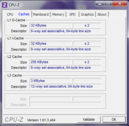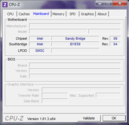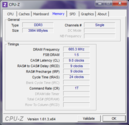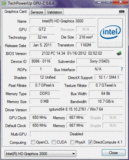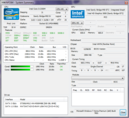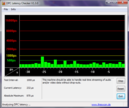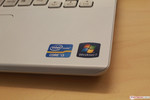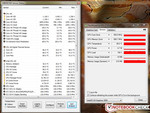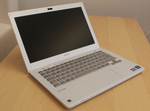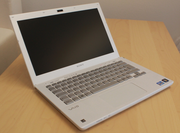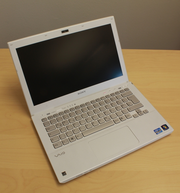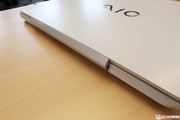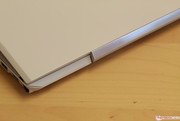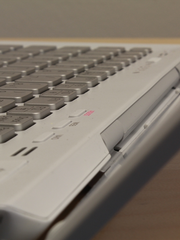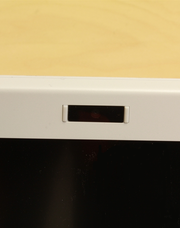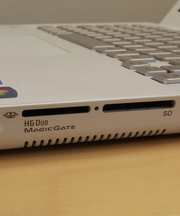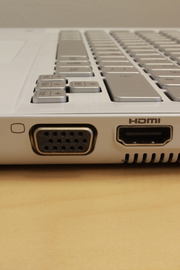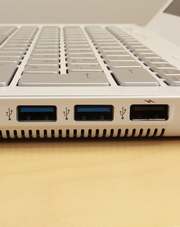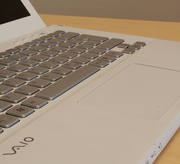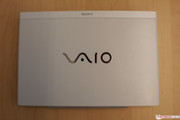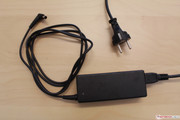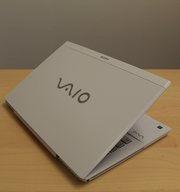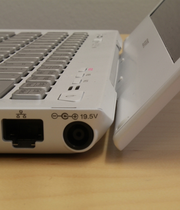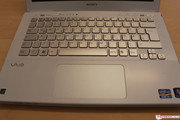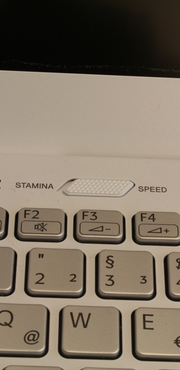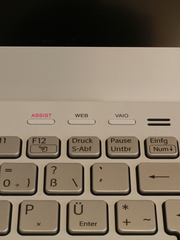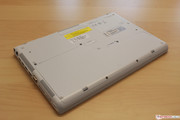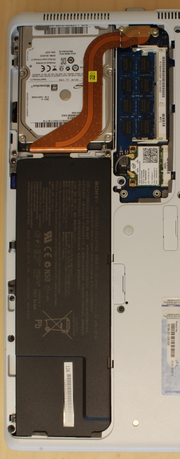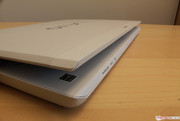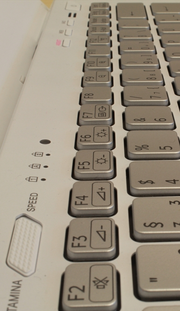Review Sony Vaio SV-S1311G4E Notebook
The SV-S131G4E wants to play with the big boys and alludes to the more expensive SV-S13A1Z9E. While the latter advances in many spheres, our test candidate remains down to earth. But that's exactly where it can demonstrate its advantages.
Processor and graphics card are united in the Intel Core i3-2350M which provides the necessary power with 2 cores at 2.3 GHz. The Intel HD Graphics 3000 is integrated in the Sandy bridge processor and the system memory is 4 GB. Overall it is solid, even though it is not a high-end machine. There are enough resources for everything - movies, music, games (under certain conditions) and work.
Case
Whether aluminum or plastic, the outer surface is dominated by the color white which does not appear to be reflective. Outside details consist of the silver VAIO logo which can also be found in a smaller version on the inside. Instead of the materials, the design speaks for itself. The design is clever in providing a gap in the front which helps the user open the laptop. In terms of design, the SV-S1311G4E resembles the premium SV-S13A1Z9E, even though plastic and aluminum bits are used instead of magnesium and carbon fiber. Unfortunately, the display is quite wobbly: It can be lifted to height of 20 mm without any much resistance.
The compact dimensions of 331 x 227 x 25 mm (13.03 x 8.94 x 0.98 inches) and the weight of 1.72 kg (3.79 pounds) does not qualify the Vaio as a true ultrabook but makes it very mobile. Overall, this is a good middle ground between the practicality (especially for display and keyboard) and the needed mobility.
Although the workmanship is elegant and almost flawless, the display has a weakness - this time when closed. Even though the hinges have decent resistance, there is quite a lot of leeway when opening it. Once positioned, there is a slight teetering. It takes a couple of seconds to come to a complete halt. This is not a large disadvantage, but leaves room for improvement. The base of the display has a neat design feature. When opened, the display locks at 135°. This might appeal to some, but not all.
There is very easy access to the battery, the hard drive, and the system memory which are all located in the bottom of the device. Only two screws separate us from the access to the said elements.
Connectivity
While the space is shared only among the DVD drive and 3.5 mm audio jack on the left side, on the right side, the distribution is a little tight. The two UBS 2.0 ports are joined by a USB 3.0 port, HDMI and VGA ports, and there are two slots for card readers (SD, SDHC, SDXC, MS Pro/Duo). Unfortunately, wide USB connectors can lead to a problem of blocking neighboring ports.
Back on the left side, we are left wondering why the 3.5 mm jack was placed towards the back. External speakers are definitely easier to connect than headphones for which every centimeter counts. We could have coped with that on a large multimedia notebook, but here, there is a conflict with the mobility of the device.
Communication
The wireless connections are possible via the Intel Centrino Advanced-N 6235 WLAN adapter (like in the SV-S13A1Z9E). It provides lightning fast transfer rates with the 802.11a/b/g/n standards. As in previous tests, 300 Mb/s speeds were reached. Here, we come across the equipment normally available in the higher priced Vaio devices.
The same goes for the HD Exmor webcam which offers a 1.3 megapixel resolution. Unfortunately, it seems like the premium devices have something over our test unit. The webcam disappoints with an acceptable image quality at best, which looks blurred and out of focus. On the other hand, the integrated microphone works great even from a distance. It is enough for video chats, but in this case, nothing more is required.
Accessories
The box can be emptied quickly as it only contains the notebook itself, the 90 W power supply and several manuals. We find more interesting content on the VAIO. Windows 7 Home Premium is already installed along with the necessary drivers. In addition, there are various programs by Sony, Microsoft Office 2010 Starter Edition, and a trial version of McAfee Internet Security.
Maintenance
As already mentioned, the system memory, the hard drive, and the battery are located behind an easily removable plastic cover which is secured by two screws. This seems a bit impractical for quick battery change, but it makes the device look elegant. Only minimal accessibility has been sacrificed in favor of the concept design.
Warranty
2 years is the standard warranty available when the notebook is purchased from an official dealer. Otherwise, the period is halved to 1 year. Sony's online shop offers an extension to 3 and 4 years costing 129.90 Euro (~$169) and 349.90 Euro (~$456) respectively.
Input Devices
Keyboard
The chiclet keyboard shimmers in silver until it is lit from underneath, but then it really shines. The key lighting not only illuminates the captions but also builds a frame around the keys. As convenient as this might be, it is also annoying. When you sit at the wrong angle in front the device, you get an unwanted glimpse of the LEDs at work under the keys.
The typing experience is pleasant throughout. The grip, resistance, and pressure points are ideal. Thus, even prolonged work on the 15 x 15 mm (0.59 inches) keys is not strenuous. Each press of a key makes a subtle noise which is not disturbing. Though, if you want a particularly silent keyboard, this might become a problem.
Due to the size, there is no separate number pad. Above the keyboard are the additional controls. Next to the left speaker grill is a button that ejects the CD/DVD and a switch that changes the energy profiles (Stamina and Speed). These also have an effect on the fan. On the right, we find the power button (also angled) and three quick access keys. These start the diagnostic software VAIO Care, the default browser, and a customizable program.
Touchpad
The 118 x 62 mm touch pad looks monolithic. The practicality of this format becomes apparent as soon as you move the mouse cursor from one end of the screen to the other, without lifting your finger. The whole pad can be used, even the not specifically marked buttons. Although in practice there is more space for cursor movement and gestures, it can be difficult to hold the mouse cursor steady while clicking. However, if you use only the finger tips, the buttons impress us with precision and crisp pressure point. Unfortunately the touch pad in the SV-S13A1Z9E left a much better impression.
Display
The 13.3-inch display with WXGA resolution of 1366x768 pixels has a sharp image in the HD format. As before, we can talk about "good standards" and peculiarities are hard to find. The matte display has an average brightness of 227 cd/m2 which is not that great - therefore the image is not particularly strong.
| |||||||||||||||||||||||||
Brightness Distribution: 91 %
Center on Battery: 233 cd/m²
Contrast: 163:1 (Black: 1.43 cd/m²)
40.94% AdobeRGB 1998 (Argyll 3D)
50.8% sRGB (Argyll 3D)
39.22% Display P3 (Argyll 3D)
We find ourselves at a point where, this time we come to terms with the color intensity. With a black level of 1.43 cd/m2 and a contrast ratio of 163:1, the Vaio is definitely not fit for professional image editing. Without such requirement, the color reproduction can be satisfying, but not impressive. The sRGB colour space remains uncovered, as is usual in this price range.
Outdoors, the matte display hardly reflects and thus scores points. Under natural light the colors and image sharpness remains crisp. Even with average brightness, the display is always legible. While it does not come close to outdoor specialists like the Samsung 900X3B (about 500 Euro more, ~$651), it does try to.
In the practical and normal working environment, the colors remain stable. There are almost no distortions horizontally. Only from a too high or too low angle are there problems and unpleasant effects.
Therefore we do not recommend using the notebook in bed with widely or barely opened display; the conventional use on the lap or on the desk brings no such problems.
Performance
The inner workings of the Vaio are versatile but not specialized for any application. The Intel Core i3-2350M with the integrated Intel HD Graphics 3000 unites GPU and CPU and this saves weight and reduces the necessary cooling with no compromise on the performance. 4 GB RAM and a whisper quiet 500 GB HDD complete the picture. There are also the loud DVD drive and an Intel WLAN card. The various ports (3x USB, HDMI and VGA) make the device a handy companion that can also undertake some tasks that require higher performance.
Without any clear specification, we can use the title "all-rounder" even if it should be used with caution. The Vaio really stands out with its components. Together, they ensure a wide range of use.
Processor
The Vaio cannot go wrong with an Intel Core i3-2350M as the heart of the system. The Sandy Bridge dual-core processor runs at 2.3 GHz and is in the entry-level range of processors.
The Cinebench R10 tests are conducted to determine the performance of the processors. In the 32-bit benchmark, the score was 2634 points with one core rendering, while both cores reached 6380 points. 2754 points was achieved in the Shading part of the benchmark.
There is not much difference in the 64-bit test - 1518 points for a single core and 7620 points in the multi-core test draw a similar picture. The 1599 points in Shading confirms this as well.
Unfortunately the processor is clocked at the desired frequency (especially noticeable in the single core tests) which is disappointing. During the single-core test we noticed throttling to 800 MHz. There is no clear reason for this. Although the 2.3 GHz frequency could be reached and maintained a couple of times, the benchmark results were still very low. This behavior was not observed in the multi-core test.
System Performance
What kind of components can you expect from a good looking notebook for 850 Euro? With a solid (though not exceptional) CPU/GPU combination and 4 GB DDR3 RAM with CL9 timing (9-9-24), the device performs decently. The above mentioned throttling of the processor does have a negative impact on the overall system performance.
In the age of the SSDs, the Vaio SV-S1311G4E is equipped with a Seagate HDD. Although, it is no rival to an SSD, it does a good job for an HDD.
On paper the combination looks great, but in practice, the two PCMark benchmarks do not show very good results. Only 811 points in PCMark Vantage and 1666 in PCMark 7 were achieved. In order to even start the latter, we had to update the video drivers first as there was a known issue with the ones that the notebook came with, which made running the benchmark impossible.
Overall the device does not come close to the Samsung 530U3B which manages to get 1951 points in the PCMark 7 and 4585 in the PCMark Vantage to outclass the Sony S13. Here too, the CPU throttling prevents a better result.
| PCMark Vantage Result | 811 points | |
| PCMark 7 Score | 1666 points | |
Help | ||
Storage Devices
The large 500 GB Seagate ST500LM012 cannot be called "Solid State Disc", but does a solid job. With an average read rate of 79.7 MBit/s and an access time of just under 20 milliseconds, the brief slump down to 1.8 MBit/s seems like a small dent in picture pretty good performance report.
Graphics Card
The integrated Intel HD Graphics 3000 with a clock frequency of 650 MHz is quiet, energy efficient, and does not overheat which is ideal for mobility. The advantages come at the expense of performance. The benchmarks show sobering results: 2478 points in 3DMark 06 and only 4334 points in the multi-core test of Cinebench.
| 3DMark 06 Standard Score | 2478 points | |
Help | ||
Gaming Performance
The poor performance was confirmed through the game test with Deus EX: Human Revolution and Anno 2070. In Deus Ex with lowest settings, 25 fps was rarely exceeded. At medium setting we were disappointed. The game is not playable running at only 11 fps. For obvious reasons, the frame rate dropped to 7 fps at highest settings. The strategy game, Anno 2070 runs at 35 fps at the lowest settings and is playable, but not enjoyable. Medium settings drop the framerates to 12 fps, and the highest settings result in 9 fps.
Gaming notebook? Negative. It is understandable that the gaming performance has been sacrificed in favor of better mobility where battery life is of prime importance.
| low | med. | high | ultra | |
|---|---|---|---|---|
| Deus Ex Human Revolution (2011) | 24 | 11 | 7 | |
| Anno 2070 (2011) | 35 | 12 | 9 |
Emissions
Noise Levels
When booting, the DVD drive greets us with a loud rattle. After this, it returns to quiet operation. At just 32.3 dB (A) in normal use, the noise level stays stable. This requires the Stamina mode to be used, which turns the cooling system to a quiet operation.
Even the loud optical drive does not exceed 35.2 dB (A) during operation. The impressive part is the HDD that can never be heard and is lost in the background noise.
The Vaio was not quite convincing in the stress test, which was conducted in the Speed mode. With a peak of 48.9 dB (A) and an average of 43.6 dB (A), the cooling system makes sure we know it exists and is active. The laptop is capable of performing at both extremes.
Noise level
| Idle |
| 32.3 / 32.3 / 32.4 dB(A) |
| HDD |
| 32.3 dB(A) |
| DVD |
| 35.2 / dB(A) |
| Load |
| 43.6 / 48.9 dB(A) |
 | ||
30 dB silent 40 dB(A) audible 50 dB(A) loud |
||
min: | ||
Temperature
Despite the compact design, the notebook does not accumulate heat. At idle, the center of the top side reached 33 degrees Celsius. The warmest point on the bottom side reached 34 degrees Celsius. Thus, the Vaio remains cool when not stressed.
Even in the stress test, neither the notebook nor the user breaks a sweat. While the bottom side reached temperature of 30.5 to 45 degrees Celsius, the keyboard did not exceed 44 degrees Celsius. The palm rests remained the coolest. Overall, the warmest region is at the back of the device.
The notebooks from the Vaio SV-S series have a switch above the keyboard that changes the energy profile (as already mentioned) and the controls the fan. In “Stamina” mode, the fan is turned down. In “Speed” mode though, all restrictions are dropped and the priority become low temperatures instead of low power consumption and noise level.
(±) The maximum temperature on the upper side is 43.8 °C / 111 F, compared to the average of 35.9 °C / 97 F, ranging from 21.4 to 59 °C for the class Subnotebook.
(-) The bottom heats up to a maximum of 45.1 °C / 113 F, compared to the average of 39.3 °C / 103 F
(+) In idle usage, the average temperature for the upper side is 30.7 °C / 87 F, compared to the device average of 30.8 °C / 87 F.
(+) The palmrests and touchpad are reaching skin temperature as a maximum (32.7 °C / 90.9 F) and are therefore not hot.
(-) The average temperature of the palmrest area of similar devices was 28.2 °C / 82.8 F (-4.5 °C / -8.1 F).
Speakers
In terms of volume, we have a real powerhouse here. Although the stereo speakers seem more like an understatement, once the music is turned on, there is no doubt about their strength. Unfortunately the same cannot be said about the quality. The sound out of the speakers is thin and unbalanced very often. Therefore you cannot utilize the maximum volume optimally. It just sounds better when the volume is not at 100%.
When brilliance is not needed, the strengths come forth. Both the microphone and speakers are ideal for internet telephony. No echo, no feedback is observed on the sounds from the speakers. This is how it must be.
Battery Life
Power Consumption
The switch above the keyboard with the words “Stamina” and “Speed” is not there for nothing. In addition to the simple switch between energy profiles, the fan is also toned down or up. This saves energy. While idle mode with “Speed” mode activated, we measured an average of 8.6 W, and with “Stamina” mode, 6.7 W was measured.
Under load, the Vaio does not perform as well, consuming up to 49.3 W of power. Despite the relatively high energy consumption, the average-sized power supply does not get hot. While in the low range, the energy consumption is satisfactory but it quickly rises. This can be mitigated via the switch, but at the expense of performance.
| Off / Standby | |
| Idle | |
| Load |
|
Key:
min: | |
Battery Runtime
Here we don't have a real long distance runner. While idle, the battery lasts 5 hours and 20 minutes. This is satisfactory but not the best. Under load with BatteryEater, the battery lasted 2 hours and 42 minutes, which is less than half of the runtime achieved during the idle test. The runtime when playing a DVD is a bit under 3 hours and come very close to the full load levels. The battery life during WLAN surfing is 4 hours and 17 minutes which is more satisfying.
Here we must again mention the switch that regulates the energy profile and the fan. If you forget to put it in the "Stamina" mode, you would lose a couple of minutes. But if you use it in mobile operation, you will quickly notice why this feature exists.
Verdict
"Me too!” shouts the Vaio SV-S1311G4E and does its best to imitate the more expensive models in the series. Partially this is a success, keeping in mind that this is no high-end notebook.
The display is acceptable, but there is no graphics card to match it. Instead of an SSD, there is a good HDD. Low power consumption under low load and high consumption under stress is behavior common to many notebooks that are cheaper. Features such as the energy profile switch and the exceptional touch pad can both delight and discourage the buyer.
The unusual throttling of the CPU is a definite disappointment. The bad score in the benchmark quickly turns into an annoyance in practice. The fact that the problem occurs only in the single-core test is no consolation.
After going back and forth, our impression landed in the middle, right where the notebook wants to be. Those looking for a middle class laptop with bits and piece of higher class devices for less than 900 Euro (~$1175) should also take a look at the competition.




